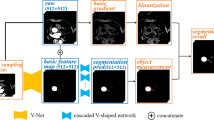Abstract
Digital subtraction angiography (DSA) is a fluoroscopic technique used to clearly visualize blood vessels. However, accurate segmentation of coronary arteries cannot be directly obtained from DSA images because of motion artifacts. In this paper, a fully convolutional network is designed to segment the coronary arteries from DSA images instead of angiographic images. First, an ORPCA method with intra-frame and inter-frame constraints is introduced to enhance the vessel structure in DSA. Then, an enhanced DSA image-guided segmentation network, which is a fully convolutional network composed of an encoder path and a decoder path, is proposed to extract the coronary arteries to learn the vascular features from the enhanced vascular structures. The experimental results demonstrate that the proposed method is more effective and accurate in coronary artery segmentation, compared with state-of-the-art methods.
Access this chapter
Tax calculation will be finalised at checkout
Purchases are for personal use only
Similar content being viewed by others

References
Yang, J., Wang, Y., Tang, S.: Multiresolution elastic registration of x-ray angiography images using thin-plate spline. IEEE Trans. Nucl. Sci. 54, 152–166 (2007)
Moccia, S., De Momi, E., Hadji, S.: Blood vessel segmentation algorithms—review of methods, datasets and evaluation metrics. Comput. Methods Programs Biomed. 158, 71–91 (2018)
Fraz, M., Remagnino, P., Hoppe, A.: Blood vessel segmentation methodologies in retinal images–a survey. Comput. Methods Programs Biomed. 108, 407–433 (2012)
Hassouna, M., Farag, A., Hushek, S.: Cerebrovascular segmentation from TOF using stochastic models. Med. Image Anal. 10, 2–18 (2006)
Goceri, E., Shah, Z., Gurcan, M.: Vessel segmentation from abdominal magnetic resonance images: adaptive and reconstructive approach. Int. J. Numer. Methods Biomed. Eng. 33, e2811 (2017)
Lupascu, C., Tegolo, D., Trucco, E.: FABC: retinal vessel segmentation using AdaBoost. IEEE Trans. Inf. Technol. Biomed. 14, 1267–1274 (2010)
Orlando, J., Blaschko, M.: Learning fully-connected CRFs for blood vessel segmentation in retinal images. In: International Conference on Medical Image Computing and Computer-Assisted Intervention, pp. 634–641 (2014)
Orlando, J., Prokofyeva, E., Blaschko, M.: A discriminatively trained fully connected conditional random field model for blood vessel segmentation in fundus images. IEEE Trans. Biomed. Eng. 64, 16–27 (2017)
Fu, H., Xu, Y., Lin, S.: Deepvessel: retinal vessel segmentation via deep learning and conditional random field. In: International Conference on Medical Image Computing and Computer-Assisted Intervention, pp. 132–139 (2016)
Luo, Y., Yang, L., Wang, L.: Efficient CNN-CRF network for retinal image segmentation. In: International Conference on Cognitive Systems and Signal Processing, pp. 157–165 (2016)
Du, C., Song, S., Ai, D.: Inter/intra-constraints optimization for fast vessel enhancement in x-ray angiographic image sequence. In: IEEE International Conference on Bioinformatics and Biomedicine, pp. 859–863 (2018)
Läthén, G., Jonasson, J., Borga, M.: Blood vessel segmentation using multi-scale quadrature filtering. Pattern Recogn. Lett. 31, 762–767 (2010)
Fan, J., Yang, J., Wang, Y.: Multichannel fully convolutional network for coronary artery segmentation in x-ray angiograms. IEEE Access 6, 44635–44643 (2018)
Krizhevsky, A., Sutskever, I., Hinton, G.: ImageNet classification with deep convolutional neural networks. In: Advances in Neural Information Processing Systems, pp. 1097–1105 (2012)
Srivastava, N., Hinton, G., Krizhevsky, A.: Dropout: a simple way to prevent neural networks from overfitting. J. Mach. Learn. Res. 15, 1929–1958 (2014)
Acknowledgement
This work was supported by the National Key R&D Program of China (2017YFC0107900), the China Postdoctoral Science Foundation (2015M580962), and the National Science Foundation Program of China (61672099, 61501030).
Author information
Authors and Affiliations
Corresponding author
Editor information
Editors and Affiliations
Rights and permissions
Copyright information
© 2019 Springer Nature Singapore Pte Ltd.
About this paper
Cite this paper
Fan, J., Du, C., Song, S., Cong, W., Hao, A., Yang, J. (2019). Enhanced Subtraction Image Guided Convolutional Neural Network for Coronary Artery Segmentation. In: Wang, Y., Huang, Q., Peng, Y. (eds) Image and Graphics Technologies and Applications. IGTA 2019. Communications in Computer and Information Science, vol 1043. Springer, Singapore. https://doi.org/10.1007/978-981-13-9917-6_59
Download citation
DOI: https://doi.org/10.1007/978-981-13-9917-6_59
Published:
Publisher Name: Springer, Singapore
Print ISBN: 978-981-13-9916-9
Online ISBN: 978-981-13-9917-6
eBook Packages: Computer ScienceComputer Science (R0)



